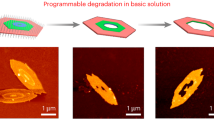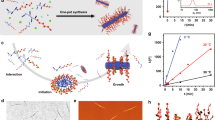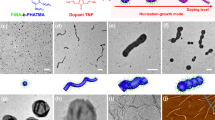Abstract
The creation of shaped, uniform and colloidally stable two-dimensional (2D) assemblies by bottom-up methods represents a challenge of widespread current interest for a variety of applications. Herein, we describe the utilization of surface charge to stabilize self-assembled planar structures that are formed from crystallizable polymer precursors by a seeded growth approach. Addition of crystallizable homopolymers with charged end-groups to seeds generated by the sonication of block copolymer micelles with crystalline cores yields uniform platelet micelles with controlled dimensions. Significantly, the seeded growth approach is characterized by a morphological memory effect whereby the origin of the seed, which can involve a quasi-hexagonal or rectangular 2D platelet precursor, dictates the observed 2D platelet shape. This new strategy is illustrated using two different polymer systems, and opens the door to the construction of 2D hierarchical structures with broad utility.
This is a preview of subscription content, access via your institution
Access options
Access Nature and 54 other Nature Portfolio journals
Get Nature+, our best-value online-access subscription
$29.99 / 30 days
cancel any time
Subscribe to this journal
Receive 12 print issues and online access
$259.00 per year
only $21.58 per issue
Buy this article
- Purchase on Springer Link
- Instant access to full article PDF
Prices may be subject to local taxes which are calculated during checkout





Similar content being viewed by others
References
Zhang, X. & Xie, Y. Recent advances in free-standing two-dimensional crystals with atomic thickness: design, assembly and transfer strategies. Chem. Soc. Rev. 42, 8187–8199 (2013).
Boott, C. E., Nazemi, A. & Manners, I. Synthetic covalent and non-covalent 2D materials. Angew. Chem. Int. Ed. 54, 13876–13894 (2015).
Zhuang, X., Mai, Y., Wu, D., Zhang, F. & Feng, X. Two-dimensional soft nanomaterials: a fascinating world of materials. Adv. Mater. 27, 403–427 (2015).
Rizis, G., van de Ven, T. G. M. & Eisenberg, A. “Raft” formation by two-dimensional self-assembly of block copolymer rod micelles in aqueous solution. Angew. Chem. Int. Ed. 53, 9000–9003 (2014).
Yang, J.-X. et al. Hydrogen-bonding-mediated fragmentation and reversible self-assembly of crystalline micelles of block copolymer. Macromolecules 49, 367–372 (2016).
Lee, I.-H. et al. Nanostar and nanonetwork crystals fabricated by in situ nanoparticlization of fully conjugated polythiophene diblock copolymers. J. Am. Chem. Soc. 135, 17695–17698 (2013).
Yin, L. & Hillmyer, M. A. Disklike micelles in water from polyethylene-containing diblock copolymers. Macromolecules 44, 3021–3028 (2011).
Keller, A. Polymer single crystals. Polymer 3, 393–421 (1962).
Geil, P. Polymer Single Crystals (Robert Krieger Pub. Huntington, NY Press, 1973).
Li, B. & Li, C. Y. Immobilizing Au nanoparticles with polymer single crystals, patterning and asymmetric functionalization. J. Am. Chem. Soc. 129, 12–13 (2007).
Dong, B., Zhou, T., Zhang, H. & Li, C. Y. Directed self-assembly of nanoparticles for nanomotors. ACS Nano 7, 5192–5198 (2013).
Chen, W. Y. et al. “Chemically shielded” poly(ethylene oxide) single crystal growth and construction of channel-wire arrays with chemical and geometric recognitions on a submicrometer scale. Macromolecules 37, 5292–5299 (2004).
Zheng, J. X. et al. Onsets of tethered chain overcrowding and highly stretched brush regime via crystalline-amorphous diblock copolymers. Macromolecules 39, 641–650 (2006).
Yu, B., Jiang, X. & Yin, J. Size-tunable nanosheets by the crystallization-driven 2D self-assembly of hyperbranched poly(ether amine) (hPEA). Macromolecules 47, 4761–4768 (2014).
Hailes, R. L. N., Oliver, A. M., Gwyther, J., Whittell, G. R. & Manners, I. Polyferrocenylsilanes: synthesis, properties, and applications. Chem. Soc. Rev. 45, 5358–5407 (2016).
Hudson, Z. M. et al. Tailored hierarchical micelle architectures using living crystallization-driven self-assembly in two dimensions. Nat. Chem. 6, 893–898 (2014).
Qiu, H. et al. Uniform patchy and hollow rectangular platelet micelles from crystallizable polymer blends. Science 352, 697–701 (2016).
Gilroy, J. B. et al. Monodisperse cylindrical micelles by crystallization-driven living self-assembly. Nat. Chem. 2, 566–570 (2010).
Petzetakis, N., Dove, A. P. & O’Reilly, R. K. Cylindrical micelles from the living crystallization-driven self-assembly of poly(lactide)-containing block copolymers. Chem. Sci. 2, 955–960 (2011).
Schmelz, J., Karg, M., Hellweg, T. & Schmalz, H. General pathway toward crystalline-core micelles with tunable morphology and corona segregation. ACS Nano 5, 9523–9534 (2011).
Wang, X. et al. Cylindrical block copolymer micelles and co-micelles of controlled length and architecture. Science 317, 644–647 (2007).
Schmelz, J., Schedl, A. E., Steinlein, C., Manners, I. & Schmalz, H. Length control and block-type architectures in worm-like micelles with polyethylene cores. J. Am. Chem. Soc. 134, 14217–14225 (2012).
Qian, J. et al. Uniform, high aspect ratio fiber-like micelles and block co-micelles with a crystalline π-conjugated polythiophene core by self-seeding. J. Am. Chem. Soc. 136, 4121–4124 (2014).
Qiu, H. et al. Branched micelles by living crystallization-driven block copolymer self-assembly under kinetic control. J. Am. Chem. Soc. 137, 2375–2385 (2015).
Qiu, H., Cambridge, G., Winnik, M. A. & Manners, I. Multi-armed micelles and block co-micelles via crystallization-driven self-assembly with homopolymer nanocrystals as initiators. J. Am. Chem. Soc. 135, 12180–12183 (2013).
Gaedt, T., Ieong, N. S., Cambridge, G., Winnik, M. A. & Manners, I. Complex and hierarchical micelle architectures from diblock copolymers using living, crystallization-driven polymerizations. Nat. Mater. 8, 144–150 (2009).
Gilroy, J. B. et al. Probing the structure of the crystalline core of field-aligned, monodisperse, cylindrical polyisoprene-block-polyferrocenylsilane micelles in solution using synchrotron small- and wide-angle X-ray scattering. J. Am. Chem. Soc. 133, 17056–17062 (2011).
Hanaor, D., Michelazzi, M., Leonelli, C. & Sorrell, C. C. The effects of carboxylic acids on the aqueous dispersion and electrophoretic deposition of ZrO2 . J. Eur. Ceram. Soc. 32, 235–244 (2012).
Xu, J., Ma, Y., Hu, W., Rehahn, M. & Reiter, G. Cloning polymer single crystals through self-seeding. Nat. Mater. 8, 348–353 (2009).
Tan, C. & Zhang, H. Epitaxial growth of hetero-nanostructures based on ultrathin two-dimensional nanosheets. J. Am. Chem. Soc. 137, 12162–12174 (2015).
Huang, X. et al. Solution-phase epitaxial growth of noble metal nanostructures on dispersible single-layer molybdenum disulfide nanosheets. Nat. Commun. 4, 1444 (2013).
Hsiao, M.-S., Yusoff, S. F. M., Winnik, M. A. & Manners, I. Crystallization-driven self-assembly of block copolymers with a short crystallizable core-forming segment: controlling micelle morphology through the influence of molar mass and solvent selectivity. Macromolecules 47, 2361–2372 (2014).
Passaglia, E. & Khoury, F. Crystal growth kinetics and the lateral habits of polyethylene crystals. Polymer 25, 631–644 (1984).
Chen, Z. et al. Structure of poly(ferrocenyldimethylsilane) in electrospun nanofibers. Macromolecules 34, 6156–6158 (2001).
Papkov, V. S. et al. Crystalline structure of some poly(ferrocenylenedialkylsilylenes). Macromolecules 33, 7107–7115 (2000).
Li, X. et al. “Cross” supermicelles via the hierarchical assembly of amphiphilic cylindrical triblock comicelles. J. Am. Chem. Soc. 138, 4087–4095 (2016).
He, W.-N. & Xu, J.-T. Crystallization assisted self-assembly of semicrystalline block copolymers. Prog. Polym. Sci. 37, 1350–1400 (2012).
Sun, L. et al. Structural reorganization of cylindrical nanoparticles triggered by polylactide stereocomplexation. Nat. Commun. 5, 5746 (2014).
Sun, L. et al. Core functionalization of semi-crystalline polymeric cylindrical nanoparticles using photo-initiated thiol-ene radical reactions. Polym. Chem. 7, 2337–2341 (2016).
Ni, Y., Rulkens, R. & Manners, I. Transition metal-based polymers with controlled architectures: well-defined poly(ferrocenylsilane) homopolymers and multiblock copolymers via the living anionic ring-opening polymerization of silicon-bridged [1] ferrocenophanes. J. Am. Chem. Soc. 118, 4102–4114 (1996).
Wang, H., Winnik, M. A. & Manners, I. Synthesis and self-assembly of poly(ferrocenyldimethylsilane-b-2-vinylpyridine) diblock copolymers. Macromolecules 40, 3784–3789 (2007).
McGrath, N. et al. Synthesis and crystallization-driven solution self-assembly of polyferrocenylsilane diblock copolymers with polymethacrylate corona-forming blocks. Polym. Chem. 5, 1923–1929 (2014).
Pratt, R. C. et al. Exploration, optimization, and application of supramolecular thiourea-amine catalysts for the synthesis of lactide (co)polymers. Macromolecules 39, 7863–7871 (2006).
McNulty, J. & Keskar, K. Discovery of a robust and efficient homogeneous silver(I) catalyst for the cycloaddition of azides onto terminal alkynes. Eur. J. Org. Chem. 2012, 5462–5470 (2012).
Acknowledgements
X.H., A.N. and X.L. are grateful to the European Union (EU) for Marie Curie Postdoctoral Fellowships. C.E.B. thanks the Bristol Chemical Synthesis Centre for Doctoral Training, funded by the Engineering and Physical Sciences Research Council (EPSRC), for a PhD studentship. PeakForce atomic force microscopy was carried out in the Chemical Imaging Facility, University of Bristol with equipment funded by EPSRC. G. R. Whittell is thanked for helpful discussions.
Author information
Authors and Affiliations
Contributions
X.H. and I.M. conceived the project with input from A.N. X.H. synthesized the polymers, and performed the experiments. X.H. and C.E.B. performed the LSCM imaging. X.H. and R.L.H. performed the AFM analysis. X.L. provided the PFS25-b-P2VP250 seeds. M.-S.H. performed the imaging and analysis of ED and EDX mapping. X.H., M.-S.H. and I.M. prepared the manuscript with input from all the other authors. The project was supervised by I.M.
Corresponding author
Ethics declarations
Competing interests
The authors declare no competing financial interests.
Supplementary information
Supplementary Information
Supplementary Information (PDF 8463 kb)
Rights and permissions
About this article
Cite this article
He, X., Hsiao, MS., Boott, C. et al. Two-dimensional assemblies from crystallizable homopolymers with charged termini. Nature Mater 16, 481–488 (2017). https://doi.org/10.1038/nmat4837
Received:
Accepted:
Published:
Issue Date:
DOI: https://doi.org/10.1038/nmat4837
This article is cited by
-
Uniform segmented platelet micelles with compositionally distinct and selectively degradable cores
Nature Chemistry (2023)
-
Amphiphilic Block Copolymer Micelles for Gene Delivery
Chemical Research in Chinese Universities (2022)
-
Precise Supramolecular Polymerization of Liquid Crystalline Block Copolymer Initiated by Heavy Metallic Salts
Chinese Journal of Polymer Science (2022)
-
Semi-conducting 2D rectangles with tunable length via uniaxial living crystallization-driven self-assembly of homopolymer
Nature Communications (2021)
-
A case study of monomer design for controlled/living supramolecular polymerization
Polymer Journal (2021)



